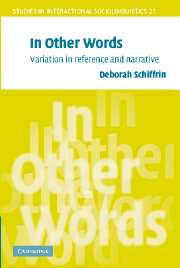Book contents
- Frontmatter
- Contents
- List of figures
- List of tables
- Preface
- 1 Variation
- 2 Problematic referrals
- 3 Anticipating referrals
- 4 Reactive and proactive prototypes
- 5 Referring sequences
- 6 Reframing experience
- 7 Retelling a story
- 8 Who did what (again)?
- 9 Redoing and replaying
- Appendix 1 Transcription conventions for data excerpts
- Appendix 2 Four versions of Susan Beer's capture story
- Appendix 3 Jack Cohen's narrative about Joey Bishop's childhood prank
- References
- Index
3 - Anticipating referrals
Published online by Cambridge University Press: 14 January 2010
- Frontmatter
- Contents
- List of figures
- List of tables
- Preface
- 1 Variation
- 2 Problematic referrals
- 3 Anticipating referrals
- 4 Reactive and proactive prototypes
- 5 Referring sequences
- 6 Reframing experience
- 7 Retelling a story
- 8 Who did what (again)?
- 9 Redoing and replaying
- Appendix 1 Transcription conventions for data excerpts
- Appendix 2 Four versions of Susan Beer's capture story
- Appendix 3 Jack Cohen's narrative about Joey Bishop's childhood prank
- References
- Index
Summary
Introduction
The linguistic form through which we refer – convey a person, place, or thing about which we will say something – is the noun phrase, either a full lexical noun (e.g. the boy, a new family on the block, my high school friends, her house) or a pronoun (e.g. he, they, we, it). Earlier chapters have explored some underlying processes of referrals (Chapter 1) and the types of problems that can arise (Chapter 2). In this chapter, I focus on repairs of what may seem like a preliminary and very small part of a referral: the articles (definite the, indefinite a) that preface a lexical noun. I identified article repairs by locating the- and a- in my corpus of sociolinguistic interviews. Analyzing the self-initiation and self-completion of article repairs helps us address both external (word-to-world) and internal (word-to-word) problems that arise as speakers and hearers work together to manage referrals.
After reviewing the functions of the and a, I present the three possible outcomes of article repairs in Section 3.2: dropping the article and noun; shifting to a different article; repeating the same article. Since the first outcome has already been noted (Chapter 2) and will be further elaborated (Chapter 4) this chapter focuses on shifting and repeating articles. Whereas article shifts reflect a variety of problems (Section 3.3), article repetitions reflect word-to-world problems that impinge on activation of a referent – local problems (Section 3.4.1) rather than sentence (Section 3.4.2), text (Section 3.4.3) or turn-taking problems (Section 3.4.4).
- Type
- Chapter
- Information
- In Other WordsVariation in Reference and Narrative, pp. 69 - 109Publisher: Cambridge University PressPrint publication year: 2006

